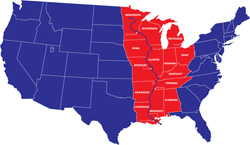What is Heartland?
 From the perspective of a US citizen, the word ‘Heart-
land’ usually refers to the Midwest, an area which
includes the north-central states of the United States
of America, specifically Illinois, Indiana, Iowa, Kansas,
Michigan, Minnesota, Missouri, Ohio, Nebraska, North
Dakota, South Dakota and Wisconsin. This terminology
however, has been stretched to accommodate various
uses, such as the ‘fly over states’ , the ‘great plaines’ and
‘the forgotten land’. In reference to the interdisciplinary
exhibition project, Heartland, we like to use this term in a
more metaphorical way – as meaning the ‘heart’ of the
country.
From the perspective of a US citizen, the word ‘Heart-
land’ usually refers to the Midwest, an area which
includes the north-central states of the United States
of America, specifically Illinois, Indiana, Iowa, Kansas,
Michigan, Minnesota, Missouri, Ohio, Nebraska, North
Dakota, South Dakota and Wisconsin. This terminology
however, has been stretched to accommodate various
uses, such as the ‘fly over states’ , the ‘great plaines’ and
‘the forgotten land’. In reference to the interdisciplinary
exhibition project, Heartland, we like to use this term in a
more metaphorical way – as meaning the ‘heart’ of the
country.
While not an official region, what Mark Twain once
called the ‘body of the nation’ encompasses for us the
area roughly in the middle of the United States, linked by
the symbolic Mississippi River. Ranging from New Orleans
in the south, up to Minneapolis in the West and Detroit
in the East, this cultural melting pot has brewed much
of the country’s social, religious and racial activism. The
presence of the Mississippi River has dominated its his-
tory being the carrier of different moments of migration,
industrialization and struggle.
Many of the vital organs of the country’s artistic and
musical expression are embedded in this middle ground
between the West and East coasts and yet this zone is
obscured on the global cultural and economic map.
As a result of this underexposure, the prevailing ste-
reotypes of rustic, small-town backwardness remain
entrenched in outsider imaginings of Mississippi Basin life
and culture. We are talking about a vast distance of land
that is more than 20 times the size of the Netherlands!
With the current US presidential elections, it becomes
even more important to look into this specific area,
beyond the clichés dominating much coverage of the
elections. Impressions of this powerful nation’s voting
behaviour received by European audiences are mostly
mediated by the East Coast of the United States. Many
of the swing vote areas, however, lie in the country’s
interior and the front runner for the Democratic party,
Barack Obama is himself based in Chicago, Illinois. A
‘swing state’ (also, battleground state or purple state) in
United States presidential politics is a state in which no
candidate has overwhelming support, which are not
historically ‘red’ or ‘blue’ states, but change constantly.
By collaborating with various independent American
and European artists, institutions and engaging within
and with independent cultural infrastructure, the interdis-
ciplinary project Heartland operates not only within the
contemporary art production but looks across other art
forms, and in particular at the area’s rich musical tradi-
tion to tell a new story about an old country.

